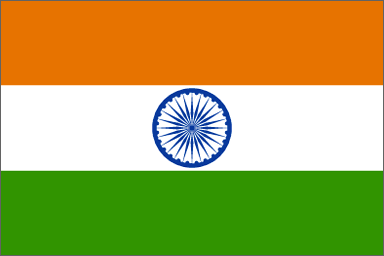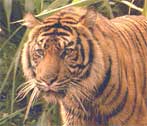|
|
|
National Flag
National Emblam
National Animal
National Bird
National Flower
National Tree
National Anthem
National Song
National Calender

The National Flag of India is made up of Khadi, with three bands of colour. Top Band is of Saffron colour, indicating the strength of the country. The white middle band, indicates peace with Dharma Chakra. The last band is green in colour shows the fertility of the land.
Top
National
Emblam

The National Emblem adapted by the Government of India on 26th January 1950, is taken from the Lion capital of Sarnath erected by Ashoka - the great Mauryan King. In the emblem only three lions are visible and the fourth one is hidden from the view. In the centre of the Abacus, there is a wheel symbolising the Dharma Chakra (Eternal wheel of law) with a bull on the right and horse on the left. The word Satyameva Jayate (Truth alone triumphs) from the Upanishadas have been inscribed in Devanagari script. The emblem is the official seal of the President of India and Central and State Governments of the Indian union. Used only for official purposes, it commands utmost respect and loyalty, while proclaiming independent India's identity and sovereignty.
Top
National
Animal - Tiger

The Tiger - Lord of the Indian Jungles, evokes royalty,
majesty and power. With its position at top of the ecological pyramids,
the tiger is the symbol of India's wealth of wildlife. India homes nearly
half the world-wide population of tigers and thus tiger remains synonymous
with India.
The magnificent tiger, Panthera tigris (Linnaeus), is
a striped animal. It has a thick yellow coat of fur with dark stripes.
The combination of grace, strength, agility and enormous power has earned
the tiger its pride of place as the national animal of India. Out of eight
races of the species known, the Indian race, the Royal Bengal Tiger, is
found throughout the country except in the north-western region and also
in the neighbouring countries, Nepal, Bhutan and Bangladesh. To check the
dwindling population of tigers in India 'Project Tiger' was launched in
April 1973. So far, 23 tiger reserves have been established in the country
under this project, covering an area of 33,126 sq km.
Top
National
Bird - Peacock

Symbolic of many qualities - grace, joy, pride, beauty,
love and mysticism, the Peacock is depicted in picture with the company
of Indian Gods and Goddesses. It is the sacred bird of the India, protected
not only by a religious sentiment but also by parliamentary statute.
The Indian peacock, Pavo cristatus (Linnaeus), the national
bird of India, is a colourful, swan-sized bird, with a fan-shaped crest
of feathers, a white patch under the eye and a long, slender neck. The
male of the species is more colourful than the female, with a glistening
blue breast and neck and a spectacular bronze-green train of around 200
elongated feathers. The female is brownish, slightly smaller than the male,
and lacks the train. The elaborate courtship dance of the male, fanning
out the tail and preening its feathers is a gorgeous sight.
The peacock is widely found in the Indian sub-continent
from the south and east of the Indus river, Jammu and Kashmir, east Assam,
south Mizoram and the whole of the lndian peninsula. The peacock enjoys
protection from the people as it is never molested for religious and sentimental
reasons. It is fully protected under the Indian Wildlife (Protection) Act,
1972.
Top
National
Flower - Lotus

Rich in meaning and metaphor, the Lotus symbolises divinity, fertility, wealth, knowledge and not to forget enlightenment. Lending to its uniqueness, the flower grows in murky waters and rises on a long stalk above the surface to bloom glorious. Untouched by the impurity, lotus symbolises the purity of heart and mind. Human beings are instructed by Indian scripture to live a life of non-attachment, which is very hard. Then in Indian thought, there is the last and final lotus - Charan Kamal or lotus feet of the Almighty. It was this depth of thought that made the founding fathers of modern India enshrine the lotus in the Constitution as the National Flower.
Top
National
Tree - Banayan

Commanding a central presence in the timeless setting of India's countryside, is the mighty Banayan, a tree endemic to the Indian subcontinent. What's amazing about this tree is the fact that it is a veritable micro habitant for countless creatures. For man it provides shelter and is a point where the village community gather and transact much of its affairs.
Top
National
Anthem
The song Jana-gana-mana, composed originally in Bengali by Rabindranath Tagore, was adopted in its Hindi version by the Constituent Assembly as the national anthem of India on 24 January 1950. It was first sung on 27 December 1911 at the Calcutta Session of the Indian National Congress. The complete song consists of five stanzas. The first stanza contains the full version of the National Anthem :
Jana-gana-mana-adhinayaka, jaya he
Bharata-bhagya-vidhata.
Punjab-Sindh-Gujarat-Maratha
Dravida-Utkala-Banga
Vindhya-iVimachala-Yamuna-Ganga Uchchala-Jaladhi-taranga.
Tava shubha name jage,
Tava shubha asisa mage,
Gahe tava jaya gatha,
Jana-gana-mangala-dayaka jaya he Bharata-bhagya-vidhata.
Jaya he, jaya he, jaya he,
Jaya jaya jaya, jaya he!
Playing time of the full version of the national anthem is approximately
52 seconds.
A short version consisting of first and last lines of the stanza
(playing time approximately 20 seconds)
is also played on certain occasions. The following is Tagore's English
rendering of the anthem :
Thou art the ruler of the minds of all people,
dispenser of India's destiny.
Thy name rouses the hearts of punjab, Sind,
Gujarat and Maratha,
Of the Dravida and Orissa and Bengal;
It echoes in the hills of the Vindyas and Himalayas,
mingles in the music of Jamuna and Ganges and is
chanted by the waves of the Indian Sea.
They pray for thy blessings and sing thy praise.
The saving of all people waits in thy hand,
thou dispenser of India's destiny.
Victory, victory, victory to thee.
Top
National
Song
The song Vande Mataram, composed in Sanskrit by Bankimchandra Chatterji, was a source of inspiration to the people in their struggle for freedom. It has an equal status with Jana-gana-mana. The first political occasion when it was sung in the 1896 session of the Indian National Congress. The following is the text of its first stanza :
Vande Mataram!
Sujalam, suphalam, malayaja shitajam,
Shasyashyamalam, Mataramt
Shubhrajyothsna puiakitayaminim,
Phullakusumita drumadala shobhinim,
Suhasinim sumadhura bhashinim,
Sukhadam varadam, Mataram!
The English translation of the stanza rendered by Sri Aurobindo in prose' is :
I bow to thee, Mother,
richly-watered, richiy-fruited,
cool with the winds of the south,
dark with the crops of the harvests,
The Mother!
Her nights rejoicing in the glory of the moonlight,
her lands clothed beautifully with her trees in flowering bloom,
sweet of laughter, sweet of speech,
The Mother, giver of boons, giver of bliss.
* As published in Volume Eight of Sri Aurobindo
Birth Centenary Library Popular Edition 1972
Top
National
Calender
The national calendar based on the Saka Era with Chaitra as its first month and a normal year of 365 days was adopted from 22 March 1957 along with the Gregorian calendar for the following official purposes: (i) Gazette of India, (ii) news broadcast by All India Radio, (iii) calendars issued by the Govemment of India and (iv) Government communications addressed to the members of the public. Dates of the national calendar have a permanent correspondence with dates of the Gregorian calendar : 1 Chaitra falling on 22 March normally and on 21 March in leap year.